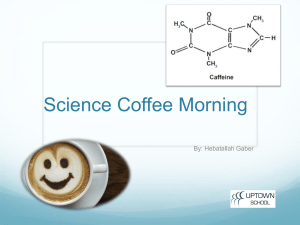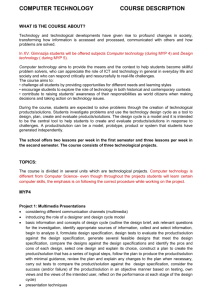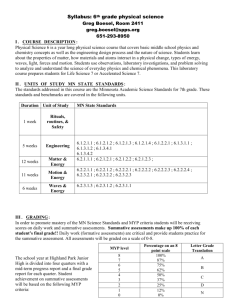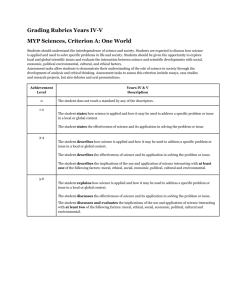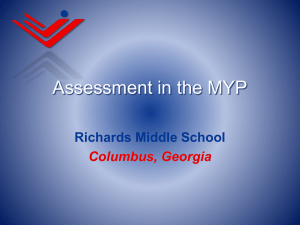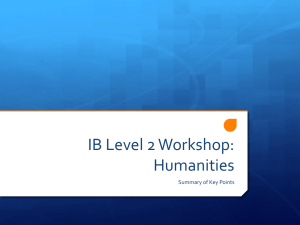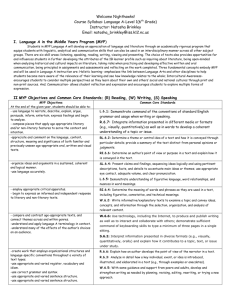MYP Assessment
advertisement
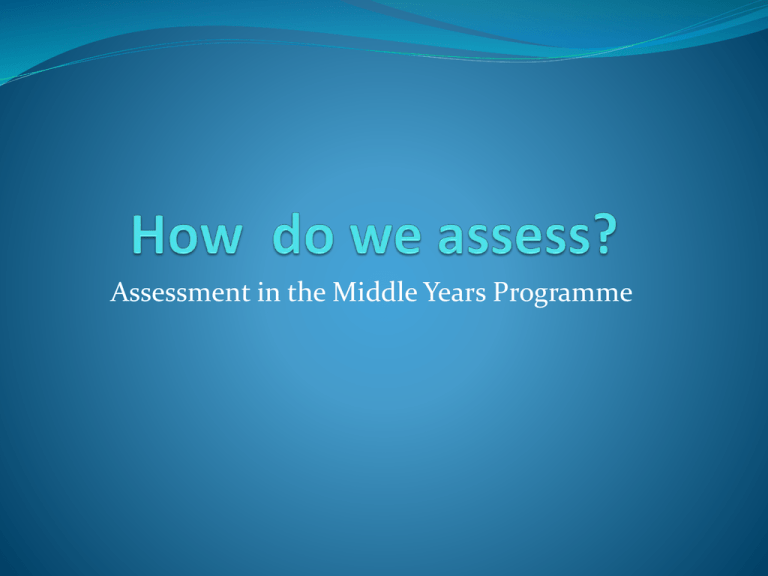
Assessment in the Middle Years Programme How are students assessed? The MYP offers a criterion-related model of assessment. This means that students' results are determined by performance against set standards, not by each student's position in the overall rank order. Teachers organize continuous assessment over the course of the programme taking account of specified criteria that correspond to the objectives for each subject. Teachers are responsible for structuring varied and valid assessment tasks that allow students to demonstrate achievement according to the required objectives within each subject group. These may include: open-ended, problem-solving activities and investigations organized debates hands-on experimentation analysis reflection. Assessment strategies are meant to provide feedback on the thinking processes as well as the finished piece of work. Formative assessment is emphasized a lot to guide the student in the learning process and towards the summative assessment. There is also an emphasis on self-assessment and peer-assessment within the programme. Aims and objectives Aims and objectives for all subjects developed by the IB. Interim objectives for MYP 1-3. Two examples out of the 8 aims for Language A The aims of the teaching and study of MYP language A are to encourage and enable students to: • use language as a vehicle for thought, creativity, reflection, learning, self-expression and social interaction • develop the skills involved in listening, speaking, reading, writing, viewing and presenting in a variety of contexts Objectives Two examples out of 15 of the Language A objectives: A Content (receptive and productive) At the end of the course, students should be able to: • understand and analyze the language, content, structure, meaning and significance of both familiar and previously unseen oral, written and visual texts • understand and apply language A terminology in context Assessment Criteria The IB has developped a set of exit assessment criteria for each individual subject. ISLK has developped modified assessment criteria for MYP 1-3 based on the interim objectives and the exit assessment criteria given by the IB. Language A: Criteria A, B and C. Language B: Criteria A-E. Humanities: A-D Sciences: A-F Mathematics: A-D Technology: A-F Physical Education: A-D Arts: A-D Achievement levels Each criterion has descriptors for different achievement levels. Example Physical education Criterion A: Use of knowledge. Maximum: 8 Criterion B: Movement composition. Maximum: 6. Criterion C: Performance. Maximum: 10. Criterion D: Social skills and personal engagement. Maximum: 8 Achievement level descriptors Example Physical Education Criterion B: Movement composition Achievement levels 0-6. Maximum 6. Descriptor 0 The student does not reach a standard described by any of the descriptors below. 1–2 The student selects some aesthetic moves that are appropriate to the requirements of the task. The student has some difficulty in adapting and/or creating moves. The sequence shows a simple use of space, time, level, force and flow. The composition is generally incoherent with many pauses, and shows limited creativity. 3–4 The student selects, adapts and creates aesthetic moves that are appropriate to the requirements of the task. The sequence shows a competent use of space, time, level, force and flow. The composition is mostly coherent, and shows some aspects of imagination and creativity. 5–6 The student selects, adapts and creates a wide range of aesthetic moves that are appropriate to the requirements of the task. The sequence shows a sophisticated use of space, time, level, force and flow. The composition is coherent, and shows aspects of imagination, creativity and style. Task specific rubric The descriptors for the different achievement levels are rewritten in order to clarify and make the task less abstract to the student. Task specific rubrics Humanities Exit criteria Criteria C and D Band 5-6 The student selects and uses relevant information. Work shows satisfactory evidence of analysis. Presentation and expression are clear. Sources of information are documented, with occasional errors in adhering to conventions. Humanities Task specific Criteria C and D Band 5-6 You select and use relevant information from your family history documentation and the work shows satisfactory evidence of analysis. Your presentation and expression are clear; attention is paid to the audience and purpose in terms of appropriate language, style and visual representation. Sources of information in your interview are documented, with occasional errors in adhering to conventions. Assessment record sheet For the teacher and the student to keep record of the assessment in each subject. In the organizer. On It’s learning. Final grades When the judgments on the various tasks have been made, teachers will be in a position to establish a final profile of achievement for each student by determining the single most appropriate level for each criterion. Where the judgments for a criterion differ, the teacher must decide which level best represents the student’s final standard of achievement. The final levels for each criterion must then be added together to give a final criterion levels total for each subject for each student. Grade boundaries The grade boundaries are based upon the results from schools who are sending in samples for moderation to the IB. They are revised every second year. Example: Language A Grade Boundaries 1 0-4 2 5-9 3 10-14 4 15-19 5 20-23 6 24-27 7 28-30 Quiz: Do you know… What does an objective mean within the MYP? What is an achievement level? What is a task specific rubric? How many different criteria can a subject have? How is the final grade determined? WELL DONE!


